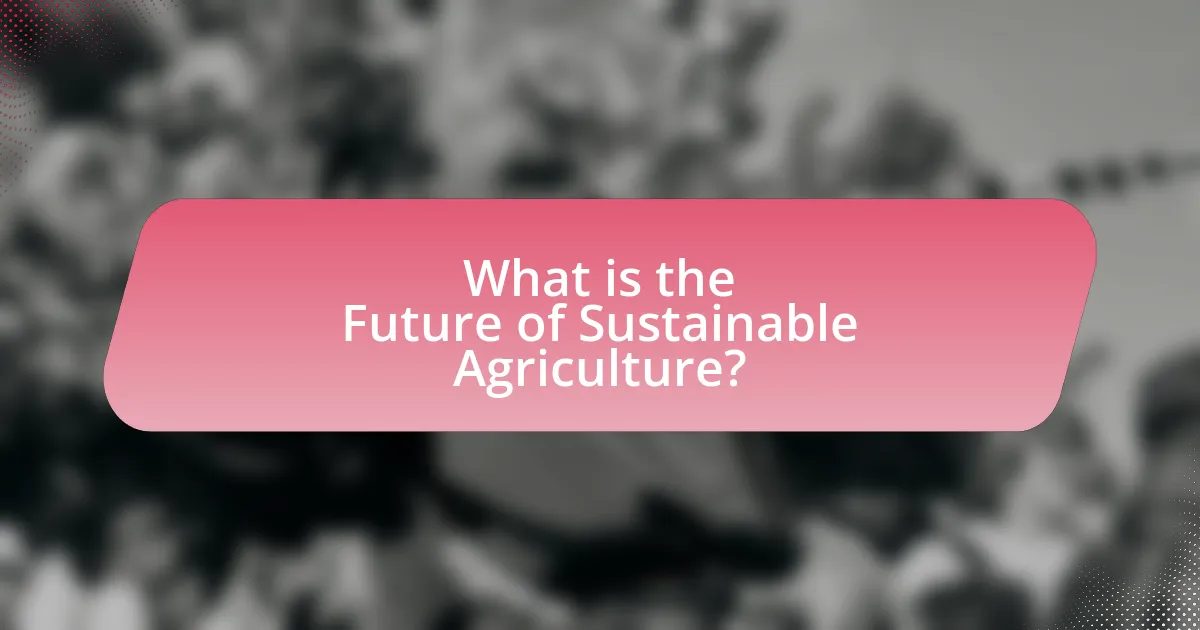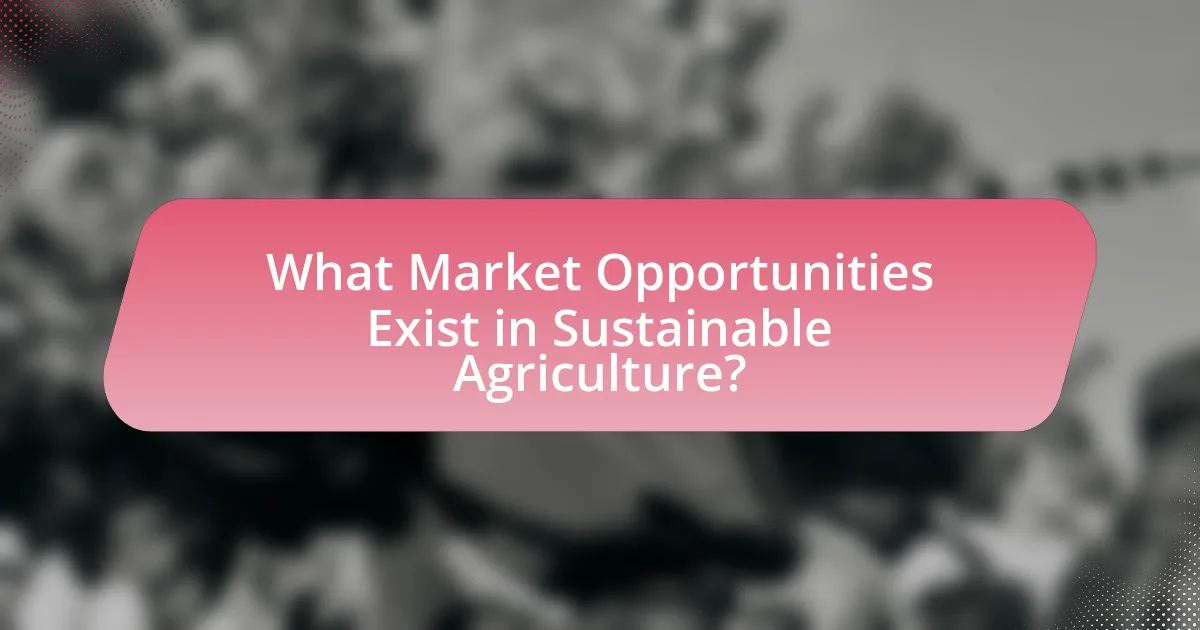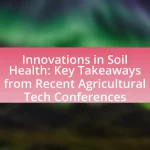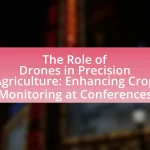The article focuses on the future of sustainable agriculture, emphasizing the integration of advanced technologies, regenerative practices, and supportive policies to enhance productivity while minimizing environmental impact. Key principles of sustainable agriculture include maintaining soil health, conserving water, promoting biodiversity, and reducing chemical inputs. The article also explores the differences between sustainable and conventional agriculture, the importance of sustainable practices for food security, and the environmental challenges they address. Additionally, it highlights emerging market opportunities driven by consumer demand for sustainable products and the role of government policies in promoting sustainable agricultural practices.

What is the Future of Sustainable Agriculture?
The future of sustainable agriculture involves the integration of advanced technologies, regenerative practices, and supportive policies to enhance productivity while minimizing environmental impact. Innovations such as precision farming, which utilizes data analytics and IoT devices, are expected to optimize resource use and reduce waste. According to a report by the Food and Agriculture Organization, sustainable practices can increase crop yields by up to 20% while conserving water and soil health. Additionally, policies promoting carbon farming and agroecology are likely to create market opportunities, as consumers increasingly demand sustainably sourced products. This shift is supported by a growing body of research indicating that sustainable agriculture can significantly contribute to food security and climate resilience.
How is sustainable agriculture defined in the context of future practices?
Sustainable agriculture is defined as farming practices that meet current food and textile needs without compromising the ability of future generations to meet their own needs. This approach emphasizes the integration of environmental health, economic profitability, and social equity. Future practices in sustainable agriculture focus on innovative techniques such as precision farming, agroecology, and regenerative practices, which enhance soil health, reduce chemical inputs, and promote biodiversity. Evidence from the Food and Agriculture Organization indicates that sustainable agriculture can increase food security while mitigating climate change impacts, demonstrating its critical role in future agricultural policies and market opportunities.
What are the key principles of sustainable agriculture?
The key principles of sustainable agriculture include maintaining soil health, conserving water, promoting biodiversity, and reducing chemical inputs. Maintaining soil health involves practices such as crop rotation and cover cropping, which enhance soil fertility and structure. Conserving water is achieved through efficient irrigation techniques and rainwater harvesting, which help to optimize water use. Promoting biodiversity includes planting a variety of crops and supporting natural ecosystems, which can improve resilience against pests and diseases. Reducing chemical inputs focuses on minimizing the use of synthetic fertilizers and pesticides, thereby decreasing environmental impact and promoting ecological balance. These principles are supported by research indicating that sustainable practices can lead to increased productivity and environmental health over time.
How does sustainable agriculture differ from conventional agriculture?
Sustainable agriculture focuses on practices that maintain ecological balance and promote long-term environmental health, while conventional agriculture often prioritizes short-term yields through the use of synthetic fertilizers and pesticides. Sustainable agriculture employs techniques such as crop rotation, organic farming, and integrated pest management, which enhance soil health and biodiversity. In contrast, conventional agriculture typically relies on monoculture and chemical inputs, leading to soil degradation and increased vulnerability to pests and diseases. Research indicates that sustainable practices can improve resilience against climate change and reduce greenhouse gas emissions, supporting the notion that sustainable agriculture is essential for future food security and environmental sustainability.
Why is the future of sustainable agriculture important?
The future of sustainable agriculture is important because it addresses the critical need for food security while minimizing environmental impact. Sustainable agriculture practices enhance soil health, conserve water, and reduce greenhouse gas emissions, which are essential for combating climate change. According to the Food and Agriculture Organization, sustainable practices can increase crop yields by up to 20% while using fewer resources, demonstrating their effectiveness in meeting global food demands. Additionally, sustainable agriculture supports biodiversity, which is vital for resilient ecosystems and long-term agricultural productivity.
What environmental challenges does sustainable agriculture address?
Sustainable agriculture addresses several environmental challenges, including soil degradation, water scarcity, loss of biodiversity, and greenhouse gas emissions. Soil degradation occurs due to practices that deplete soil nutrients and structure, leading to reduced agricultural productivity. Water scarcity is exacerbated by conventional farming methods that consume excessive water resources, threatening both crop yields and local ecosystems. Loss of biodiversity results from monoculture practices, which diminish the variety of species in agricultural landscapes, impacting ecosystem resilience. Additionally, sustainable agriculture aims to reduce greenhouse gas emissions by promoting practices such as crop rotation and agroforestry, which sequester carbon and lower the carbon footprint of farming operations. These practices collectively contribute to a more sustainable and resilient agricultural system.
How does sustainable agriculture contribute to food security?
Sustainable agriculture enhances food security by promoting practices that increase agricultural productivity while preserving environmental health. These practices, such as crop rotation, agroforestry, and organic farming, improve soil fertility and biodiversity, leading to more resilient food systems. For instance, a study by the Food and Agriculture Organization (FAO) indicates that sustainable agricultural methods can increase yields by up to 30% in developing countries, thereby directly addressing food scarcity. Additionally, sustainable agriculture reduces dependency on chemical inputs, which can lead to long-term cost savings for farmers and more stable food prices, further contributing to food security.
What trends are shaping the future of sustainable agriculture?
Key trends shaping the future of sustainable agriculture include precision farming, agroecology, and the integration of technology such as artificial intelligence and blockchain. Precision farming utilizes data analytics to optimize resource use, leading to reduced waste and increased yields; for instance, a study by the Food and Agriculture Organization (FAO) indicates that precision agriculture can increase crop productivity by up to 20%. Agroecology emphasizes biodiversity and ecosystem health, promoting practices that enhance soil fertility and resilience against climate change. Additionally, the adoption of technology, including AI for predictive analytics and blockchain for supply chain transparency, is transforming agricultural practices, as evidenced by a report from McKinsey & Company highlighting that digital technologies could increase agricultural productivity by 70% by 2050. These trends collectively contribute to a more sustainable agricultural system that addresses environmental challenges while meeting global food demands.
How are technological advancements influencing sustainable farming practices?
Technological advancements are significantly influencing sustainable farming practices by enhancing efficiency, reducing resource consumption, and improving crop yields. Precision agriculture technologies, such as GPS-guided equipment and soil sensors, allow farmers to apply water, fertilizers, and pesticides more accurately, minimizing waste and environmental impact. For instance, a study published in the journal “Agricultural Systems” found that precision agriculture can reduce fertilizer use by up to 30%, leading to lower runoff and improved soil health. Additionally, innovations like vertical farming and hydroponics enable food production in urban areas, reducing transportation emissions and land use. These advancements collectively contribute to more sustainable agricultural systems, aligning with global goals for food security and environmental conservation.
What role do consumer preferences play in the evolution of sustainable agriculture?
Consumer preferences significantly influence the evolution of sustainable agriculture by driving demand for environmentally friendly products. As consumers increasingly prioritize sustainability, farmers and agricultural businesses adapt their practices to meet these preferences, leading to a shift towards organic farming, reduced pesticide use, and improved animal welfare standards. For instance, a 2021 survey by the Food Marketing Institute found that 73% of consumers are willing to pay more for sustainable products, indicating a clear market trend that encourages producers to adopt sustainable practices. This consumer-driven demand not only shapes agricultural methods but also impacts policy decisions, as governments respond to the growing market for sustainable goods.

What are the Policy Implications of Sustainable Agriculture?
The policy implications of sustainable agriculture include the need for regulatory frameworks that promote environmentally friendly practices, support for research and development, and incentives for farmers to adopt sustainable methods. These policies can lead to improved soil health, reduced greenhouse gas emissions, and enhanced biodiversity. For instance, the Food and Agriculture Organization (FAO) emphasizes that sustainable agricultural practices can increase food security while minimizing environmental impacts. Additionally, policies that encourage crop diversification and organic farming can help mitigate risks associated with climate change and market fluctuations.
How do government policies impact sustainable agriculture?
Government policies significantly impact sustainable agriculture by shaping regulations, providing financial incentives, and promoting research and development. For instance, policies such as subsidies for organic farming and grants for sustainable practices encourage farmers to adopt environmentally friendly methods. According to the USDA, programs like the Environmental Quality Incentives Program (EQIP) have allocated over $1 billion annually to support sustainable practices, demonstrating the effectiveness of government intervention in promoting sustainability in agriculture. Additionally, regulations on pesticide use and water management directly influence farming practices, pushing for more sustainable approaches that protect natural resources.
What types of policies promote sustainable agricultural practices?
Policies that promote sustainable agricultural practices include environmental regulations, financial incentives, and educational programs. Environmental regulations, such as the Clean Water Act, enforce standards that protect water quality and encourage practices like crop rotation and reduced pesticide use. Financial incentives, including subsidies for organic farming and grants for sustainable technology, motivate farmers to adopt eco-friendly methods. Educational programs provide training on sustainable practices, helping farmers understand the benefits and implementation of techniques like agroforestry and integrated pest management. These policies collectively support the transition to sustainable agriculture by fostering compliance, financial viability, and knowledge dissemination.
How can policy frameworks be improved to support sustainable agriculture?
Policy frameworks can be improved to support sustainable agriculture by integrating comprehensive incentives for environmentally friendly practices. These incentives can include financial subsidies for farmers who adopt sustainable methods, tax breaks for organic farming, and grants for research into sustainable technologies. Evidence from the European Union’s Common Agricultural Policy shows that targeted subsidies can lead to a 20% increase in the adoption of sustainable practices among farmers. Additionally, establishing clear regulations that promote biodiversity and soil health can further enhance the effectiveness of these frameworks. For instance, the implementation of the U.S. Conservation Reserve Program has successfully reduced soil erosion by 90 million tons annually, demonstrating the positive impact of well-structured policies on sustainable agricultural outcomes.
What are the challenges in implementing sustainable agriculture policies?
Implementing sustainable agriculture policies faces several challenges, including economic constraints, lack of technical knowledge, and resistance from stakeholders. Economic constraints arise from the initial investment required for sustainable practices, which can deter farmers who are already operating on thin margins. Lack of technical knowledge among farmers and agricultural workers can hinder the adoption of innovative practices necessary for sustainability. Additionally, resistance from stakeholders, including agricultural businesses and consumers who may prioritize short-term gains over long-term sustainability, complicates policy implementation. These challenges are supported by studies indicating that financial barriers and knowledge gaps are significant obstacles in transitioning to sustainable agricultural systems.
What barriers do policymakers face in promoting sustainable practices?
Policymakers face several barriers in promoting sustainable practices, including economic constraints, lack of public awareness, and political resistance. Economic constraints arise from limited funding and resources allocated for sustainability initiatives, which can hinder the implementation of effective policies. Lack of public awareness leads to insufficient support for sustainable practices, as citizens may not understand their benefits or importance. Political resistance often stems from vested interests in traditional industries that may oppose changes to established practices. These barriers collectively impede the advancement of sustainable agriculture policies, as evidenced by studies indicating that regions with stronger public engagement and funding support see more successful implementation of sustainable practices.
How can stakeholders collaborate to overcome these challenges?
Stakeholders can collaborate to overcome challenges in sustainable agriculture by forming multi-sector partnerships that leverage shared resources and expertise. These partnerships can include farmers, government agencies, NGOs, and private sector companies working together to develop innovative solutions, share best practices, and implement sustainable technologies. For instance, the USDA’s Sustainable Agriculture Research and Education program has successfully facilitated collaboration among diverse stakeholders, resulting in improved agricultural practices and increased resilience to climate change. By aligning their goals and pooling their knowledge, stakeholders can effectively address issues such as resource scarcity, market access, and environmental impact.

What Market Opportunities Exist in Sustainable Agriculture?
Market opportunities in sustainable agriculture include organic farming, agroecology, and precision agriculture technologies. The organic food market has seen significant growth, with global sales reaching approximately $120 billion in 2020, reflecting a rising consumer demand for sustainably produced food. Agroecology promotes biodiversity and ecosystem health, offering farmers the chance to enhance productivity while reducing reliance on chemical inputs. Additionally, precision agriculture technologies, such as drones and soil sensors, enable farmers to optimize resource use, leading to cost savings and increased yields. These trends indicate a robust potential for investment and innovation in sustainable agricultural practices.
What are the emerging markets for sustainable agricultural products?
Emerging markets for sustainable agricultural products include Southeast Asia, Latin America, and parts of Africa. These regions are experiencing increased demand for organic and sustainably produced goods due to rising consumer awareness and government support for sustainable practices. For instance, the organic food market in Southeast Asia is projected to grow at a compound annual growth rate of 10% from 2021 to 2026, driven by a growing middle class and health-conscious consumers. In Latin America, countries like Brazil and Mexico are expanding their organic farming sectors, with Brazil being the largest organic producer in the region. Additionally, Africa is seeing a surge in sustainable agriculture initiatives, particularly in countries like Kenya and South Africa, where there is a focus on agroecology and sustainable farming practices to combat food insecurity and climate change.
How is consumer demand shifting towards sustainable products?
Consumer demand is increasingly shifting towards sustainable products as consumers prioritize environmental impact and ethical sourcing. This trend is evidenced by a 2021 Nielsen report indicating that 73% of global consumers are willing to change their consumption habits to reduce environmental impact. Additionally, a 2022 McKinsey survey found that 60% of consumers are willing to pay more for sustainable products, highlighting a growing willingness to invest in eco-friendly options. This shift is driven by heightened awareness of climate change, increased availability of sustainable products, and a desire for transparency in supply chains.
What role do certifications play in market opportunities for sustainable agriculture?
Certifications significantly enhance market opportunities for sustainable agriculture by providing credibility and assurance to consumers regarding the environmental and social practices of producers. These certifications, such as USDA Organic or Fair Trade, signal compliance with established standards, which can lead to increased consumer trust and willingness to pay premium prices. For instance, a study by the Organic Trade Association reported that organic food sales reached $62.5 billion in 2020, reflecting a growing consumer preference for certified products. Additionally, certifications can open access to niche markets and distribution channels that prioritize sustainability, further expanding market reach for certified producers.
How can businesses capitalize on sustainable agriculture trends?
Businesses can capitalize on sustainable agriculture trends by integrating eco-friendly practices into their operations and product offerings. This includes adopting regenerative farming techniques, which enhance soil health and biodiversity, and investing in technologies that reduce waste and energy consumption. For instance, a report by the Food and Agriculture Organization indicates that sustainable practices can increase crop yields by up to 30% while reducing greenhouse gas emissions. Additionally, businesses can tap into the growing consumer demand for organic and locally sourced products, which has seen a market growth of 12% annually in recent years. By aligning their strategies with these trends, businesses not only improve their sustainability profile but also enhance their market competitiveness and profitability.
What strategies can companies adopt to enter the sustainable agriculture market?
Companies can adopt several strategies to enter the sustainable agriculture market, including investing in innovative technologies, forming partnerships with local farmers, and focusing on organic certification. Investing in technologies such as precision agriculture can enhance efficiency and reduce resource use, which is critical in sustainable practices. Forming partnerships with local farmers allows companies to leverage existing knowledge and networks, facilitating smoother market entry. Additionally, obtaining organic certification can help companies build credibility and attract environmentally conscious consumers, as the organic market has seen significant growth, with sales reaching over $50 billion in the U.S. in 2021. These strategies collectively position companies to effectively navigate and succeed in the sustainable agriculture sector.
How can innovation drive market growth in sustainable agriculture?
Innovation can drive market growth in sustainable agriculture by enhancing productivity, reducing costs, and improving resource efficiency. For instance, precision agriculture technologies, such as drones and IoT sensors, enable farmers to monitor crop health and optimize inputs, leading to higher yields and lower environmental impact. According to a report by the Food and Agriculture Organization, the adoption of innovative practices can increase agricultural productivity by up to 30% while minimizing resource use. Furthermore, advancements in biotechnology, such as genetically modified organisms (GMOs), can lead to crops that require fewer pesticides and fertilizers, thus appealing to environmentally conscious consumers and expanding market opportunities.
What best practices should be followed in sustainable agriculture?
Best practices in sustainable agriculture include crop rotation, organic farming, integrated pest management, and conservation tillage. Crop rotation enhances soil health and reduces pest and disease cycles, leading to increased yields. Organic farming avoids synthetic fertilizers and pesticides, promoting biodiversity and soil fertility. Integrated pest management combines biological, cultural, and chemical practices to minimize environmental impact while controlling pests effectively. Conservation tillage reduces soil erosion and improves water retention, contributing to sustainable land use. These practices are supported by research indicating that sustainable agriculture can increase productivity while preserving natural resources, as highlighted in studies by the Food and Agriculture Organization.
How can farmers implement sustainable practices effectively?
Farmers can implement sustainable practices effectively by adopting integrated pest management, crop rotation, and conservation tillage. Integrated pest management reduces reliance on chemical pesticides, promoting biodiversity and ecosystem health. Crop rotation enhances soil fertility and reduces pest and disease cycles, leading to higher yields over time. Conservation tillage minimizes soil erosion and improves water retention, which is crucial for maintaining soil health. Research indicates that these practices can increase farm profitability while reducing environmental impact, as evidenced by a study from the University of California, which found that farms using these methods saw a 20% increase in yield and a 30% reduction in input costs over five years.
What resources are available for farmers transitioning to sustainable agriculture?
Farmers transitioning to sustainable agriculture can access various resources, including government programs, educational materials, and financial assistance. The USDA offers programs like the Environmental Quality Incentives Program (EQIP), which provides financial and technical assistance to implement conservation practices. Additionally, organizations such as the Sustainable Agriculture Research and Education (SARE) program provide grants and educational resources focused on sustainable practices. Research indicates that farmers utilizing these resources can improve soil health and increase crop yields, demonstrating the effectiveness of transitioning to sustainable methods.















